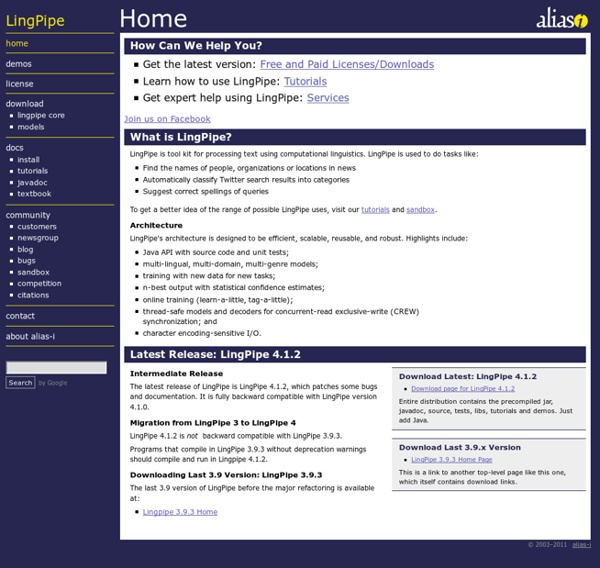Free Keyword Phrase List Generator
SEO Tools Tools to help you build and market your website. Firefox ExtensionsWeb Tools If you need feedback or have any burning questions please ask in the community forum so we can get them sorted out. Overview
Цикл надочікувань 2012 — Гартнер визначила рівень зрілості понад 1900 нових технологій
Gartner's 2012 Hype Cycle for Emerging Technologies Identifies "Tipping Point" Technologies That Will Unlock Long-Awaited Technology Scenarios 2012 Hype Cycle Special Report Evaluates the Maturity of More Than 1,900 Technologies Gartner to Host Complimentary Webinar "Emerging Technologies Hype Cycle: What's Hot for 2012 to 2013," Today at 10 a.m. EDT and 1 p.m.
List of free resources to learn Natural Language Processing - ParallelDots
Natural Language Processing (NLP) is the ability of a computer system to understand human language. Natural Langauge Processing is a subset of Artificial Intelligence (AI). There are multiple resources available online which can help you develop expertise in Natural Language Processing. In this blog post, we list resources for the beginners and intermediate level learners. Natural Language Resources for Beginners A beginner can follow two methods i.e.
Google Analytics Trick: See The Full Referring URL
If you use Google Analytics to track your websites stats, you have probably realized that Google doesn’t let you see the full URL of the sites referring traffic to you. That’s a basic feature that somehow is not included in GA but fortunately for us, there is a simple trick you can implement to display the full URL of the referring site. Before I explain you this trick, let me give full credit to Ruben Yau for actually coming up with it. I also want to thank Ruben for replying to my comment/question on his blog so quickly. As stated above, Google Analytics doesn’t let you see from what specific page your visitors are coming. For example, instead of showing this as the traffic referrer:
A Review of the Neural History of Natural Language Processing
This is the first blog post in a two-part series. The series expands on the Frontiers of Natural Language Processing session organized by Herman Kamper and me at the Deep Learning Indaba 2018. Slides of the entire session can be found here. This post will discuss major recent advances in NLP focusing on neural network-based methods.
Zero Intelligence Agents
This happens to be one of those rare instances where the benefit of hindsight does not make me regret something said flippantly on a panel. I deeply believe that in order to truly change the world we cannot simply "throw analytics at the problem." To that end, the medical and health industries are perhaps the most primed to be disrupted by data and analytics.
The Illustrated BERT, ELMo, and co. (How NLP Cracked Transfer Learning) – Jay Alammar – Visualizing machine learning one concept at a time
The year 2018 has been an inflection point for machine learning models handling text (or more accurately, Natural Language Processing or NLP for short). Our conceptual understanding of how best to represent words and sentences in a way that best captures underlying meanings and relationships is rapidly evolving. Moreover, the NLP community has been putting forward incredibly powerful components that you can freely download and use in your own models and pipelines (It’s been referred to as NLP’s ImageNet moment, referencing how years ago similar developments accelerated the development of machine learning in Computer Vision tasks).
What is Google Consumer Surveys? - Consumer Surveys Help
What is Google Consumer Surveys Google Consumer Surveys is a market research tool that allows market researchers to easily create online surveys in order to help make more informed business decisions. Users complete survey questions in order to access high quality content around the web, and publishers get paid as their users answer. For the Google Opinion Rewards App, those users complete questions to get Google Play credits. Google automatically analyzes responses, providing the data back to market researchers through a simple online interface. Where do my survey responses go?
Floyd–Warshall algorithm
. A single execution of the algorithm will find the lengths (summed weights) of the shortest paths between all pairs of vertices, though it does not return details of the paths themselves. The Floyd–Warshall algorithm was published in its currently recognized form by Robert Floyd in 1962. However, it is essentially the same as algorithms previously published by Bernard Roy in 1959 and also by Stephen Warshall in 1962 for finding the transitive closure of a graph.[1] The modern formulation of Warshall's algorithm as three nested for-loops was first described by Peter Ingerman, also in 1962.
DiffRank
Omar Odibat and Chandan K. Reddy Networks have been extensively used to model various complex systems such as online social networks, co-authorship and citation networks and gene networks. Due to different kinds of variations such as temporal, spatial, topic and phenotypic variations, several variants of the same network may exist. For several practical problems, identifying the nodes that are changing between the networks provide vital information regarding the dynamics of the network states.



